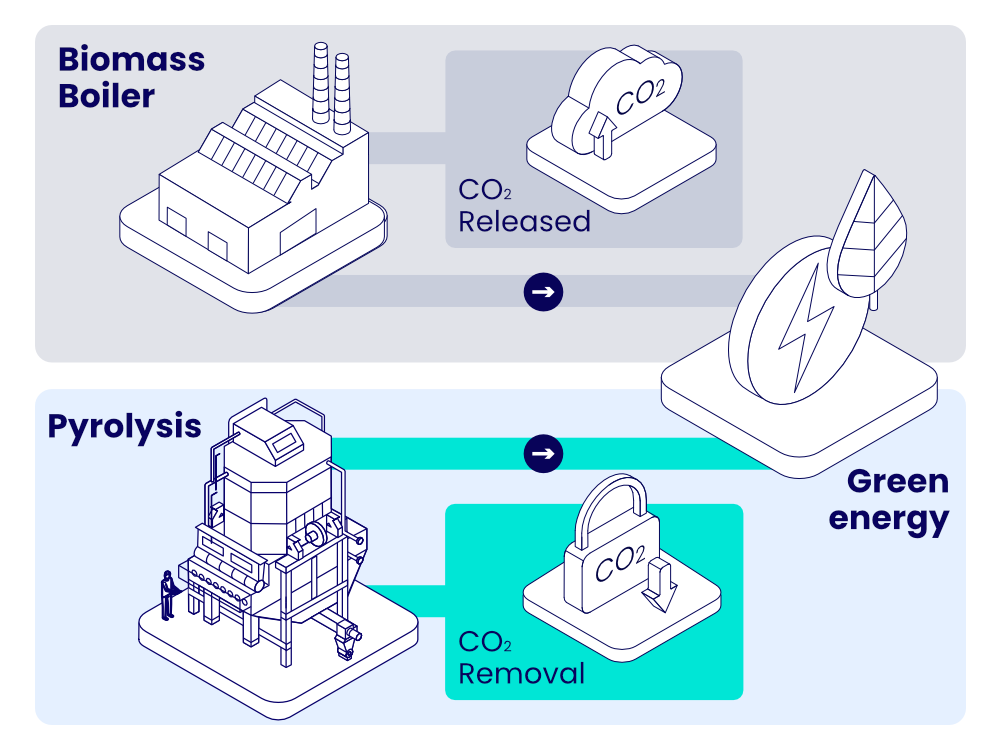Green energy
Even after pyrolysis and drying, there can enough energy left over to make a real impact on your decarbonisation plans.

Energy in multiple forms
The exact amount of energy available for external use will depend of the calorific value of the feedstock, and the drying requirements. But in almost all cases pyrolysis, requires no external energy inputs and is a source of green energy which can be used locally to offset emissions, or in the case of electricity, sold back to the grid.
Hot air, hot water & steam
The syngas will be combusted on site to provide hot air which can be used to create hot water or steam for industrial processes or heating.
Electricity Generation
An Organic Rankine Cycle (ORC) or steam turbine system can be used to transfer the thermal energy into mechanical and electrical energy.
Pyrolysis energy flows and applications
Plant Use
Self Sustaining
A portion of the syngas released from pyrolysis is combusted in the reactor to keep the process running at required temperatures. This is a necessary energy requirement for running the pyrolysis plant continuously.
Drying
If the feedstock requires drying, it can be powered by the output of the heat exchanger, ensuring efficient use of energy and optimum performance of the pyrolysis process.
Parasitic Load
The PyroUnity system can be made
self-sufficient in terms of electricity requirements if an ORC is installed, or can be externally obtained. Typical parasitic load of a dual C-1000 plant is 40 kW.
Pyrolysis
The process of pyrolysis generates syngas, which when combusted releases a tremendous amount of energy.
Heat Exchanger
The combusted gases are passed through a heat exchanger, most often using water to transfer heat to where it is required.
ORC/Steam Turbine
The hot water can optionally be passed through an Organic Rankine Cycle (ORC) or a Steam Turbine Machine to generate electricity. Some residual heat is also available from this process.
External Use
High Heating Requirements
For industries with processes requiring high temperatures, such as furnaces or kilns, flue gases can be diverted delivering temperatures of up to 600C.
Regular Heating Requirements
Hot water of air can be delivered at temperatures of up to 95C, suitable for steam production, ambient heating or log drying.
Electricity generation
With sufficient heat available, the ORC can generate electricity for local use, or sale to the grid generating income for the plant.
How does pyrolysis compare to other renewables?
Most renewable energy projects generate electricity only, and in the case of solar and wind are intermittent. Pyrolysis energy can deliver heat too, and constantly available.

Want to know more about green energy?
We can discuss your energy usage and examine opportunities you may have within your waste.
How is it different to biomass energy?

The burning of biomass as fuel involves oxidisation, and while it will release more energy than with pyrolysis, it also delivers all the CO2 contained in it back into the atmosphere, and without the necessary filters, particulate matter.
Because pyrolysis doesn't involve oxygen, most of the carbon is retained in the biochar, and the syngas is hydrogen-rich, making it far cleaner to combust.
So with the additional benefits of carbon removal and biochar, it is a far more environmentally positive, and profitable use of biomass.






